|
|
|
Sort Order |
|
|
|
Items / Page
|
|
|
|
|
|
|
| Srl | Item |
| 1 |
ID:
127619
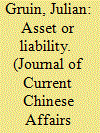

|
|
|
|
|
| Publication |
2013.
|
| Summary/Abstract |
China's financial system, dominated by the banking sector, has played a central role in the development of an imbalanced trajectory of economic development and growth. As one of the primary mechanisms for implementing decisive macro-economic policy, the banking sector has hitherto served the Chinese growth strategy well in actively allocating capital towards the investment and export sectors, whilst proving capable of managing the macro-economic ramifications of this highly inter-ventionist strategy. However, the role of the financial system in this growth strategy is also rooted in the requirement that authority over financial capital remains closely tied to state institutions and policies, due to elite concern over politico-economic instability. Based on policy analysis and qualitative interviews conducted in mid-2012, the article suggests that whilst the structure of the financial system was conducive to fostering the growth of the real economy, it will hold back not the need for rebalancing, but rather the process of rebalancing itself.
|
|
|
|
|
|
|
|
|
|
|
|
|
|
|
|
| 2 |
ID:
086472
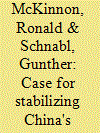

|
|
|
|
|
| Publication |
2009.
|
| Summary/Abstract |
China's financial conundrum arises from two sources. First, its large saving (trade) surplus results in a currency mismatch because it is an immature creditor that cannot lend in its own currency. Instead, foreign currency claims (largely US dollars) build up within domestic financial institutions. Second, economists, both American and Chinese, mistakenly attribute the surpluses to an undervalued RMB. To placate the USA, the result was a gradual and predictable appreciation of the RMB against the dollar of 6 percent or more per year from July 2005 to July 2008. Together with the fall in US interest rates since mid-2007, this oneway bet in the foreign exchanges markets not only attracted hot money inflows but inhibited private capital outflows from financing China's huge trade surplus. Therefore, the People's Bank of China had to intervene heavily to prevent the RMB from ratcheting upwards, and so became the country's sole international financial intermediary as official exchange reserves exploded. Because of the currency mismatch, floating the RMB is neither feasible nor desirable, and a higher RMB would not reduce China's trade surplus. Instead, monetary control and normal private-sector finance for the trade surplus require a return to a credibly fixed nominal RMB/USD rate similar to that which existed between 1995 and 2004. However, for any newly reset RMB/USD rate to be credible as a monetary anchor, foreign "China bashing" to get the RMB up must end. Then the stage would be set for fiscal expansion to both stimulate the economy and reduce its trade surplus.
|
|
|
|
|
|
|
|
|
|
|
|
|
|
|
|
| 3 |
ID:
102254
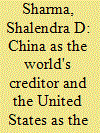

|
|
|
|
|
| Publication |
2010.
|
| Summary/Abstract |
China is now the world's leading creditor nation, while the United States is the world's largest debtor. Beijing is the largest foreign holder of US government debt - passing Japan in 2008 to become, in effect, the US government's largest foreign creditor. While some claim this gives Beijing unprecedented power over the United States, others claim that China's power is in fact greatly circumscribed. This paper shows that although current patterns of economic interdependence between the two economies invariably pushes each towards cooperation, China is deeply concerned about the future trajectory of the US economy and is already engaged in loosening the bonds of interdependence. This has profound implications for Sino-US relations and the global economy.
|
|
|
|
|
|
|
|
|
|
|
|
|
|
|
|
| 4 |
ID:
113007
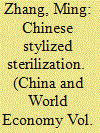

|
|
|
|
|
| Publication |
2012.
|
| Summary/Abstract |
This paper attempts to explain why sterilized intervention was so successful and sustainable in China during the first decade of the 21st century. We argue that the Chinese Government established a sterilization cost-sharing mechanism among the People's Bank of China, commercial banks and the household sector. On the one hand, Chinese commercial banks have to assume some of the sterilization costs by purchasing low yield central bank bills and maintaining high levels of required reserves. On the other hand, Chinese households assume some of the sterilization costs by bearing negative real deposit interest rates. The cost-sharing mechanism under financial repression prevents a huge quasi-fiscal loss by the People's Bank of China as well as high inflation. However, Chinese households have become victims of this financial repression. Faced with the pressure of changing the growth model from investment-driven to domestic consumption-driven, the interest rate will have to be liberalized eventually, which will, in turn, make sterilized intervention unsustainable.
|
|
|
|
|
|
|
|
|
|
|
|
|
|
|
|
| 5 |
ID:
116515
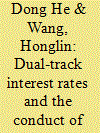

|
|
|
|
|
| Publication |
2012.
|
| Summary/Abstract |
China has a dual-track interest-rate system: bank deposit and lending rates are regulated while money and bond rates are market-determined. The central bank also imposes an indicative target, which may not be binding at all times, for total credit in the banking system. We develop and calibrate a theoretical model to illustrate the conduct of monetary policy within the framework of dual-track interest rates and a juxtaposition of price- and quantity-based policy instruments. We show the transmission of monetary policy instruments to market interest rates, which, together with the indicative credit target in the banking system, ultimately are the means by which monetary policy affects the real economy. The model shows that market interest rates are most sensitive to changes in the benchmark deposit interest rates, significantly responsive to changes in the reserve requirements, but not particularly reactive to open market operations. These theoretical results are verified and supported by both linear and GARCH models using daily money and bond market data. Overall, the findings of this study help us to understand why the central bank conducts monetary policy in China the way it does, using a combination of price and quantitative instruments with differing degrees of potency in terms of their influence on the cost of credit.
|
|
|
|
|
|
|
|
|
|
|
|
|
|
|
|
| 6 |
ID:
128150
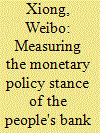

|
|
|
|
|
| Publication |
2012.
|
| Summary/Abstract |
The People's Bank of China (PBC) has employed a range of different instruments in the implementation of its monetary policy over the past decades, so perhaps no single instrument would constitute an adequate representation of the monetary policy stance. We thus develop a new policy stance index, and examine it in an ordered probit model, which follows the studies by Gerlach (2004) and He and Pauwels (2008). The empirical results show that in a backward-looking model, monetary policy reacts to actual output growth; one the other hand, when deviations from trend levels are considered, the PBC concerns inflation most seriously. In a forward-looking model, when we examine the PBC's statements in its quarterly Monetary Policy Executive Report from 2001Q1 to 2010Q3, it seems that the PBC's assessment of the prospects for inflation plays a key role determining the PBC's monetary policy stance. Our conclusions suggest that the PBC is informally targeting inflation, although no explicit target has ever been announced to the public by the PBC.
|
|
|
|
|
|
|
|
|
|
|
|
|
|
|
|
| 7 |
ID:
116498
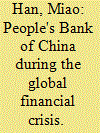

|
|
|
|
|
| Publication |
2012.
|
| Summary/Abstract |
During the economic crises of?the last decade or so, China suffered limited losses; this is evident from studies of both the 1997 Asian Financial Crisis (AFC) and the 2008 global financial crisis (GFC). China has gone on to achieve unparalleled GDP growth since the second half of 2009, when most of the developed world still struggled to recover. Throughout this period central banks have widely employed various instruments to manage the various crises. Although the People's Bank of China (PBC) has adopted complicated facilities to mitigate contagion from the global market, China's uncompleted financial reform has initially limited its exposure to external shocks. This paper therefore explores the PBC's role and its emerging limitations by comparing its performance in these two crises. Although the PBC has assisted China to achieve its immediate target of economic recovery, economic imbalance has been in effect deteriorated from the longer-term perspective due to internal susceptibility to external shocks.
|
|
|
|
|
|
|
|
|
|
|
|
|
|
|
|
| 8 |
ID:
083945
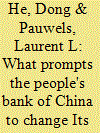

|
|
|
|
|
| Publication |
2008.
|
| Summary/Abstract |
In the present paper, we model the policy stance of the People's Bank of China (PBC) as a latent variable, and the discrete changes in the reserve requirement ratio, policy interest rates, and the scale of open market operations are taken as signals of movement of this latent variable. We run a discrete choice regression that relates these observed indicators of policy stance to major trends of macroeconomic and financial developments, which are represented by common factors extracted from a large number of variables. The predicted value of the estimated model can then be interpreted as the implicit policy stance of the PBC. In a second step, we estimate how much of the variation in the PBC's implicit stance can be explained by measures of its policy objectives on inflation, growth and financial stability. We find that deviations of CPI inflation from an implicit target and deviations of broad money growth from the announced targets, but not output gaps, figure significantly in the PBC's policy changes.
|
|
|
|
|
|
|
|
|
|
|
|
|
|
|
|
| 9 |
ID:
142950
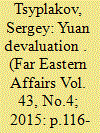

|
|
|
| 10 |
ID:
147022
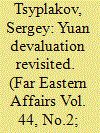

|
|
|
|
|
| Summary/Abstract |
This author continues to discuss the subject dealt with in last year's article titled Yuan Devaluation: Causes and Consequences. He examines the circumstances connected with China's further steps in reforming the yuan exchange rate - setting mechanism and yuan devaluation at the end of 2015-beginning of 2016.
|
|
|
|
|
|
|
|
|
|
|
|
|
|
|
|
|
|
|
|
|